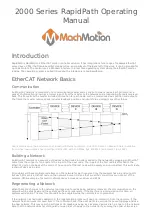
030-803-J0 Rev B
Page 5 of 26
output current. If temperature continues to increase, a shutdown of the rectifier is initiated. The rectifier shall
restart automatically if the temperature has returned to a safe level.
2.6
Wide AC Range
A minor alarm is generated when the AC input voltage drops below specification. Rectifier output power is
reduced linearly between 176Vac and 150Vac to 75% of the rated output power (the unit will deliver derated
output power down to 80Vac).
At 80Vac, the module will shut down and will not restart until the AC is greater than or equal to 150Vac; however,
the restart voltage depends on the load current. At reduced load current the unit may restart with the input voltage
as low as 100Vac.
For voltages above 277Vac, power factor and total harmonic distortion may be derated. Up to 320Vac, the
rectifier will be operational and shall not suffer any damage.
2.7
AC Inrush/Transient Suppression
The inrush current of the rectifier module is limited to the full load steady state line current to prevent surge on the
AC line. Modules are also protected from input lightning and transient surges in accordance with IEEE/ANSI
C62.41 Category B3.
2.8
Soft Start
To eliminate an instantaneous demand on the AC source, a soft start feature is employed. Soft Start, sometimes
referred to as “current walk-in”, works by gradually (up to five seconds) ramping the current limit up from zero to
the actual or defined customer setting. The rectifier output voltage is ramped up from the minimum voltage to the
float voltage.
2.9
Start Delay
The rectifier modules are equipped with a delay timer in order to stagger start a series of modules to prevent
excessive loading of generators upon start up. The built-in timer delays the turn on of the module depending on
the value selected (up to 120 seconds) via the CXC. A minimum one-second delay is preset to allow charging of
the input capacitors.
2.10 Current Limit/Short Circuit Protection
The current limit function determines the maximum output current limit of the rectifier module, regardless of output
voltage or power. Maximum output current is limited to a constant value down to short circuit condition. Current
limiting can be used to mate the rectifier output current ampacity to the needs of the load and parallel battery to
minimize excessive battery recharge current.
The rectifier will sustain a short circuit at the output terminals indefinitely. The maximum short circuit current shall
not exceed 105% of the rated full load current.
2.11 Power Limiting
Each rectifier module is designed to limit power output to the module specification. This enables more current to
be supplied at lower output voltages, and allows matching of output to the demand of constant power loads,
normally seen with telecom equipment.
This feature may also be used for a faster recharge of flooded batteries paralleled with the load.
NOTE:
Current limiting overrides the power-limiting feature.
2.12 High Voltage Shutdown (HVSD)
This feature provides protection to the load from over voltage conditions originating from the rectifiers. It operates
by shutting down the offending rectifier module when a high output voltage condition occurs. Indication is through
the red Alarm (Module Fail) LED. Modules will restart automatically; however, if more than three over voltage
conditions occur in one minute, the module will latch off and remain shut down until it is reset via the CXC.
















































